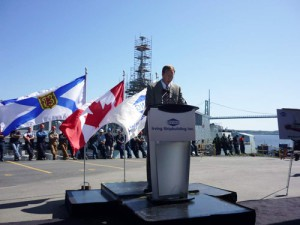
Pop culture cannot seem to escape the allure of dragons and white walkers, as HBO’s Game of Thrones (GoT), based on the book series A Song of Ice and Fire by R.R. Martin, has enthralled millions. On the face of it the fictional setting of Westeros bear little resemblance to that in which the Marines traditionally operate (commercials not included). However, examining that world, and in particular the fate of two of its warring factions, provides interesting insights for current Marine Corps issues. Both groups, despite their seemingly polar opposite nature, are at critical junctures and face decisions as to how they will conduct operations in the future – offering alternative frameworks that I believe improve upon the “middleweight” force that the Corps seeks to become.
House Greyjoy (motto: “We do not sow”) could reasonably be classified as Westerosi Marines. They are a small, intensely martial, and overwhelmingly amphibious force that has little trouble succeeding tactically, but do not always employ their forces with deep strategic foresight. They are relatively poor when compared to other noble houses, and, without large lands to farm or grow on, rely on their raiding abilities and superior military skills. The correlation with many current and historical USMC trends is readily apparent. Importantly, the “Ironborn,” as they are known, make several strategic errors when they decide to stretch their force and capabilities over a large band of conflict by taking large fixed defense castles while simultaneously raiding along the coastline.
A different group from the series is the “Brotherhood without Banners,” an insurgent group made of deserters, POWs, and other flotsam from the horrible conflict driving the story’s main narrative. These men and women unite under a radical new philosophy that rejects many of the “truths” the lands’ lords hold. They are quite successful at insurgency using methods that refuse to acknowledge the rules governing other forces’ military action, and are keen trainers of indigenous forces. Their doctrine comes only from what they have learned by blood and conflicts with the conception of warfare held by elder kings and knights. They have skills of proven utility, but it is unclear as the series now stands how the brotherhood will parlay those skills into victory in a changing conflict.
I highlight these two fictional accounts to bring to light what I consider to be the main challenges facing the Marine Corps. Will the Corps steam fully ahead into its self-proclaimed “middleweight” future and retain the hard-won lessons of 10 years of insurgency combat? Will it regain its slightly rusty amphibious roots to meet the strategic needs of our Nation? Or, will it just be a group of raiders who have little ability to affect change across the shoreline? These are all questions the Marine Corps is currently grappling with, and I offer a few observations within the GoT analogy.
Both the Brotherhood and Ironborn suffer – not when they leverage their core competencies, but when they venture outside of them. The Ironborn repeatedly face disaster when they decide to commit to larger, set-piece battles with land powers where they incur strategic losses. The Brotherhood would be better served by raising indigenous forces that can help give those who have suffered the most from war a chance at self-security rather than relying on the major houses to try and supplement their fighting abilities, as they try to do as they move south. The Brotherhood is also at risk of a lack of a coherent strategic vision, fighting only against what exists rather than spelling out a vision of their own.
Back in the real world, the Marine Corps is progressing back to its Ironborn origins by returning to its amphibious roots. This return is irrefutably necessary as the worry of many Marines is that recent events have turned the Corps into a second land army. But many of its junior leaders are equally worried the lessons they paid for in blood will be forgotten as they were after previous wars. Vital capabilities to train indigenous forces, conduct preemptive counter-insurgency (COIN), and use a light footprint to get to the “strategic left side of boom” will increasingly be at risk as more Marine Corps “meat and potato” deployments take the place of COIN operations. Our advisor capability (read: Brotherhood without Banners) is unlikely to go away completely, but it is not likely to receive the same emphasis it has had over the past few years.
Likewise, the stretching nature of a “middleweight” force seems to necessitate straddling a larger spectrum of conflict than focusing on one or two Marine Expeditionary Brigades (MEB) denied entry operations. Middleweight fighters are multi-use. But they are also slow when going up against lightweights and unable to throw knockouts against heavyweights. By shooting for the gap between “small” SOF and “big” Army are we searching to find a rationalization instead of focusing on what we have done successfully? I see this problem as similar to the Ironborn deciding to commit to taking the stronghold of Winterfell and other lands, while still conducting coastal raids, and thereby doing neither well.

I propose that the Corps refocus on amphibious operations, but primarily towards kinetic denied entry operations at the Marine Expeditionary Unit (MEU) level or higher. With this capability available, our secondary effort should be towards robust engagement vis-a-vis security cooperation, advisor capability, and retention of the lessons from COIN. A “middleweight” force is inherently focused on numbers and end strength – but this is only one consideration of organizing for future conflicts. An alternative framework would be to focus the Corps’ composition on time-based crisis response, with advisor formations to prevent conflicts and larger elements strictly focusing on highly kinetic operations at the beginning of those conflicts that do erupt. This framework would allow Marines to better focus training, equipment tables, and procurement. Operational units would be designed for long-duration advisor missions or kick the door into highly kinetic situations before letting larger Army units take over. Many might say that is or should be USMC doctrine, but a look back at the past ten years of war contradicts such a statement.
I highlight again the faults of the Ironborn in focusing on the tactical considerations of what they could capture and how, and not paying attention to the political aspects of the conflict around them. One tactical commander, Theon Greyjoy, thought that by taking Winterfell as quickly as possible his force would secure a great victory, when in fact they only rushed themselves into a strategic dead-end. A di-polar force that is focused on when to respond in a crisis allows us to focus on our historic strengths while not losing our recent capabilities. The Marine Corps must strive to think of innovative approaches to these challenges so we do not become the tactically successful, but strategically insignificant Brotherhood, nor, the operationally brilliant but strategically harebrained Ironborn as we navigate our real-world military problems in light of a coming fiscal winter.
Capt Christopher Barber is an officer in the U.S. Marine Corps who has deployed twice to Helmand Province, Afghanistan. The views expressed above are solely those of the authors and do not necessarily represent those of the U.S. Marine Corps, the Department of Defense, or the Center for International Maritime Security.



